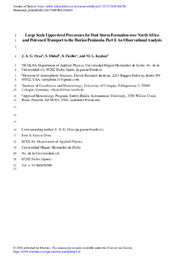Please use this identifier to cite or link to this item:
https://hdl.handle.net/11000/35185Full metadata record
| DC Field | Value | Language |
|---|---|---|
| dc.contributor.author | Garcia Orza, Jose Antonio | - |
| dc.contributor.author | Dhital, Saroj | - |
| dc.contributor.author | Fiedler, Stephanie | - |
| dc.contributor.author | Kaplan, Michael Lewis | - |
| dc.contributor.other | Departamentos de la UMH::Física Aplicada | es_ES |
| dc.date.accessioned | 2025-01-23T20:08:11Z | - |
| dc.date.available | 2025-01-23T20:08:11Z | - |
| dc.date.created | 2020 | - |
| dc.identifier.citation | Atmospheric Environment | es_ES |
| dc.identifier.isbn | 1878-2442 | - |
| dc.identifier.issn | 1352-2310 | - |
| dc.identifier.uri | https://hdl.handle.net/11000/35185 | - |
| dc.description.abstract | The analysis of three extreme African dust outbreaks over the Iberian Peninsula (IP) shows that a double Rossby wave breaking (RWB) process in the polar jet (PJ) creates the conditions for dust storm formation over subtropical deserts in North Africa and the restructuring of upper-level air flows critical for the dust transport poleward after ablation. Two consecutive anticyclonic RWBs initiate over the IP and the adjacent Atlantic, the first commencing 10 days before dust reaches the IP and the second three to five days later. The first RWB becomes quasi-stationary over the eastern Mediterranean when the second RWB develops. In turn, the first RWB blocks downstream propagation of the second, which is amplified by energy reflection poleward from the first break causing vortex intensification and equatorward propagation over the Atlas as well as a strengthening and coupling of the subtropical jet (STJ) to circulations in the ITCZ. Zonal flows are blocked and sustained low-level northeasterlies/easterlies are induced across northwest Africa. The three events present substantial differences in the location and geometry of key upper- and low-level subsynoptic features that organize the dust storms over the Sahara following the second break. Dust lifted by either the cold outflow from convective downdrafts or by orographic gravity waves interacts with terrain-induced and larger scale circulations and is transported to the IP. The location of the cyclonic large scale signal from the second RWB to the west or over the Atlas and the blocking of zonal flows are key for the poleward dust transport. | es_ES |
| dc.format | application/pdf | es_ES |
| dc.format.extent | 39 | es_ES |
| dc.language.iso | eng | es_ES |
| dc.publisher | Elsevier | es_ES |
| dc.relation.ispartofseries | 237 | es_ES |
| dc.rights | info:eu-repo/semantics/openAccess | es_ES |
| dc.rights | Attribution-NonCommercial-NoDerivatives 4.0 Internacional | * |
| dc.rights.uri | http://creativecommons.org/licenses/by-nc-nd/4.0/ | * |
| dc.subject | Saharan dust storm | es_ES |
| dc.subject | upper-level disturbance | es_ES |
| dc.subject | Rossby wave breaking | es_ES |
| dc.subject | multi-scale 50 adjustment | es_ES |
| dc.subject | poleward dust transport | es_ES |
| dc.subject.other | CDU::5 - Ciencias puras y naturales::53 - Física | es_ES |
| dc.title | Large scale upper-level precursors for dust storm formation over North Africa and poleward transport to the Iberian Peninsula. Part I: An observational analysis | es_ES |
| dc.type | info:eu-repo/semantics/article | es_ES |
| dc.relation.publisherversion | https://doi.org/10.1016/j.atmosenv.2020.117688 | es_ES |

View/Open:
2-Preprint-OpenDocument-Q1-JAGOrza-1-s2.0-S1352231020304209-am-Large scale upper level precursors.pdf
Preprint
22,74 MB
Adobe PDF
Share:
.png)
